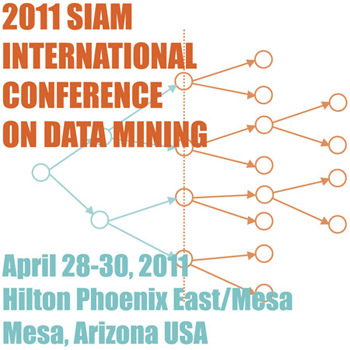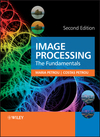
Phoenix, Arizona, USA, April 28 - April 30, 2011
URL: http://www.siam.org/meetings/sdm11
Important Dates:
Paper Submission: 11:59pm, October 15, 2010 (PST)
Author Notification: December 22, 2010
Workshop/Tutorial Proposals: 11:59pm, October 15, 2010
Camera Ready: January 25, 2011
Data mining is an important tool in science, engineering, industrial processes, healthcare, business, and medicine. The datasets in these fields are large, complex, and often noisy. Extracting knowledge requires the use of sophisticated, high-performance and principled analysis techniques and algorithms, based on sound theoretical and statistical foundations. These techniques in turn require powerful visualization technologies; implementations that must be carefully tuned for performance; software systems that are usable by scientists, engineers, and physicians as well as researchers; and infrastructures that support
them. This conference provides a venue for researchers who are addressing these problems to present their work in a peer-reviewed forum. It also provides an ideal setting for graduate students and others new to the field to learn about cutting-edge research by hearing outstanding invited speakers and attending tutorials (included with conference registration). A set of focused workshops are also held on the last day of the conference. The proceedings of the conference are published in archival form, and are also made available on the SIAM web site.


 Two weeks after the operating system itself
Two weeks after the operating system itself 
 Following the success of the first edition, this thoroughly updated second edition of Image Processing: The Fundamentals will ensure that it remains the ideal text for anyone seeking an introduction to the essential concepts of image processing. New material includes image processing and colour, sine and cosine transforms, Independent Component Analysis (ICA), phase congruency and the monogenic signal and several other new topics. These updates are combined with coverage of classic topics in image processing, such as orthogonal transforms and image enhancement, making this a truly comprehensive text on the subject.
Following the success of the first edition, this thoroughly updated second edition of Image Processing: The Fundamentals will ensure that it remains the ideal text for anyone seeking an introduction to the essential concepts of image processing. New material includes image processing and colour, sine and cosine transforms, Independent Component Analysis (ICA), phase congruency and the monogenic signal and several other new topics. These updates are combined with coverage of classic topics in image processing, such as orthogonal transforms and image enhancement, making this a truly comprehensive text on the subject. 

 Abstract: Recent advances in the fields of digital photography, networking and computing, have made it easier than ever for users to store and share photographs. However without sufficient metadata, e.g., in the form of tags, photos are difficult to find and organize. In this paper, we describe a system that recommends tags for image annotation. We postulate that the use of low-level global visual features can improve the quality of the tag recommendation process when compared to a baseline statistical method based on tag co-occurrence. We present results from experiments conducted using photos and metadata sourced from the Flickr photo website that suggest that the use of visual features improves the mean average precision (MAP) of the system and increases the system's ability to suggest different tags, therefore justifying the associated increase in complexity.
Abstract: Recent advances in the fields of digital photography, networking and computing, have made it easier than ever for users to store and share photographs. However without sufficient metadata, e.g., in the form of tags, photos are difficult to find and organize. In this paper, we describe a system that recommends tags for image annotation. We postulate that the use of low-level global visual features can improve the quality of the tag recommendation process when compared to a baseline statistical method based on tag co-occurrence. We present results from experiments conducted using photos and metadata sourced from the Flickr photo website that suggest that the use of visual features improves the mean average precision (MAP) of the system and increases the system's ability to suggest different tags, therefore justifying the associated increase in complexity. 

 Now available...
Now available... 

